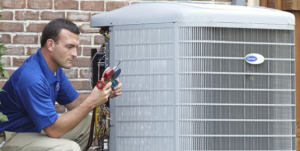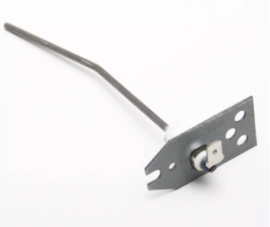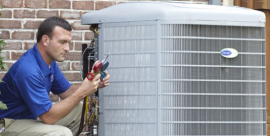- Kenmore refrigerator water filters
- Whirlpool refrigerator water filters
- Samsung refrigerator water filters
- GE refrigerator water filters
- LG refrigerator water filters
- Frigidaire refrigerator water filters
- KitchenAid refrigerator water filters
- Maytag refrigerator water filters
- Kenmore Elite refrigerator water filters
- Estate refrigerator water filters
- GE Profile refrigerator water filters
- Amana refrigerator water filters
- Bosch refrigerator water filters
- Dacor refrigerator water filters
- Electrolux refrigerator water filters
Maintaining your air conditioner


Keeping your central air conditioner in top shape with regular maintenance won’t just keep you cool in the summer, it can help lower your electric bill. A clean and well-maintained air conditioner uses less energy as it cools your home.
Maintaining your air conditioner properly also helps the environment. Using less electrical energy helps reduce carbon emissions from electric power plants that use natural gas to generate electricity.
Here are the maintenance steps you can take to keep your air conditioner working smoothly and efficiently all summer long.
Change the air filter
Replacing the air filter regularly is essential to the smooth operation of your heating and cooling system.
Dirty air filters leave particles like dust, mites, pollen and pet dander in the air, which reduces air quality in your home. Dirty air filters also make your cooling system work harder to move air, which raises energy bills and shortens the system's life.
Changing the AC air filter regularly is an essential maintenance step that’s often missed by many homeowners. Set a recurring reminder on your smart phone will help you remember this step if you’ve been missing it.
Pour bleach or vinegar down the condensate drain vent
Many central air conditioners have a condensate drain pipe that carries water collected by the evaporator during cooling to the outside of your home. If that drain pipe gets clogged with mold, algae, snails or bugs, the condensate water will back up in the drain pipe and trip a float switch near the inside unit. The system will shut off when that float switch detects a clogged condensate drain.
Pour a cup of liquid bleach or vinegar down the condensate drain vent tube every month to keep the drain pipe clear. The bleach or vinegar kills mold and mildew that can build up inside the drain pipe and hose. To keep from killing the grass in your yard, stick a pan under the drain hose outside to catch the bleach as it runs out. And always remember to protect your eyes and skin when handling bleach and other harsh chemicals. You can get in the habit of doing this at the same time you change your air filter.
Keep plants and shrubs away from condenser coils
Don’t let vegetation creep in on your outside condenser unit. For good airflow, you’ll need to keep at least 2 feet of clearance on all sides of the condenser. Trim or remove any plants, shrubs or grass that grow too close to the condenser unit.
Keeping the condenser unit clear helps the condenser coils cool down the refrigerant before it enters the evaporator and expands to cool the air in your home. The AC unit cools more efficiently when the condenser coils cool the refrigerant down effectively.
Clean the condenser cooling fins
During summer, clean the condenser fins every month to keep cooling air flowing through the condenser coils. This short video shows how to clean the condenser coil fins.
Schedule AC cleaning & maintenance service by Sears
Schedule Air Conditioner Cleaning & Maintenance Service at Sears Home Services, and a technician will come out to do a full inspection and make sure all systems are good to go. That way, your air conditioner will be ready to keep you cool this summer. Regular HVAC maintenance can help your air conditioner run more efficiently and prevent costly repairs down the road.
A Sears Technician will perform these steps to tune-up your central air conditioner for summer.
1. Check the thermostat
The technician will examine the thermostat inside your house to make sure it’s working properly and securely attached to the wall. The tech will also check thermostat settings and review the settings with you.
2. Examine the air filter
Even though you may already change the air filter regularly, the technician will check it and make sure the filter is clean and not restricted.
3. Check electrical connections
The technician will shut off electrical power to the central air conditioner and check the electrical connections to make sure all wires are connected properly. Loose wiring connections can cause cooling problems. Fixing any loose wires during maintenance will help prevent unexpected failures during the summer.
4. Lubricate the blower motor if necessary
The blower inside the indoor unit occasionally need lubrication. The tech will check the blower fan and its motor – lubricating parts if necessary. This will help keep the blower working efficiently all summer long.
5. Make sure the system controls and safety circuits work properly
The cooling system in your home has safety circuits and controls that keep the AC operating safely and efficiently. The technician will check the operation of controls to ensure that the system works properly and safely.
6. Check and clean the condensate drain line
Hopefully, the technician will find this drain line clear because you’re already pouring bleach or vinegar down the drain line regularly. The tech will make sure that the entire drain system works properly and is completely unclogged.
7. Measure air flow through the evaporator
The technician will check the air flow going through the evaporator fins and look for bent or damaged fins that could restrict air flow. Proper air flow through the evaporator is essential for proper cooling throughout your home.
8. Examine the outside condenser unit
While examining the outside condenser unit, the tech will:
Check pressures in the sealed system.
Make sure that the compressor is running properly.
Check wiring, the condenser fan and the capacitor.
Lubricate the fan if necessary.
Wash the condenser fins.
Having a Sears Technician perform thorough maintenance and cleaning of your central air conditioner will help keep your unit in top shape so it cools dependably all summer long. Regular maintenance will also help your AC last longer. Trust Sears to help you stay cool this summer – book your AC preventative maintenance check today.
Most common symptoms to help you fix your heating & cooling combined units
Choose a symptom to see related heating and air conditioning system repairs.
Thermostat problem, clogged air filter, burner failure…
Dirty air filter, clogged condenser coils, low refrigerant charge, faulty compressor…
Thermostat problems, bad compressor/condenser fan capacitor, lack of refrigerant, failed compressor…
Dirty flame sensor, failed flame sensor, damaged burner, bad high limit switch…
Main causes: errant thermostat settings, lack of electrical power, clogged drain line, wiring failure, control failure.…
Main causes: Errant thermostat settings, lack of power, bad interlock switches, lack of exhaust ventilation, wiring fail…
Most common repair guides to help fix your heating & cooling combined units
These step-by-step repair guides will help you safely fix what’s broken on your HVAC system.

How to unclog the air conditioner drain line
The condensate drain line for your central air conditioner can clog with mold and mildew. Water will back up and start d…
Repair difficulty
Time required
15 minutes or less

How to replace the furnace flame sensor
The flame sensor detects when furnace burner flames are lit. You may need to replace the flame sensor if flames only sta…
Repair difficulty
Time required
15 minutes or less

How to replace a heating and air conditioning system thermostat
The control thermostat for your HVAC system can stop working. This repair guide shows how to replace it.…
Repair difficulty
Time required
30 minutes or less
Effective articles & videos to help repair your heating & cooling combined units
Use the advice and tips in these articles and videos to get the most out of your HVAC system.

Learn how to maintain your central air conditioner to keep it running smoothly all summer long.…

Learn about all the convenient features on our Sears PartsDirect website that make your parts purchases easier.…

Get answers to frequently asked questions about Sears and Sears PartsDirect.…